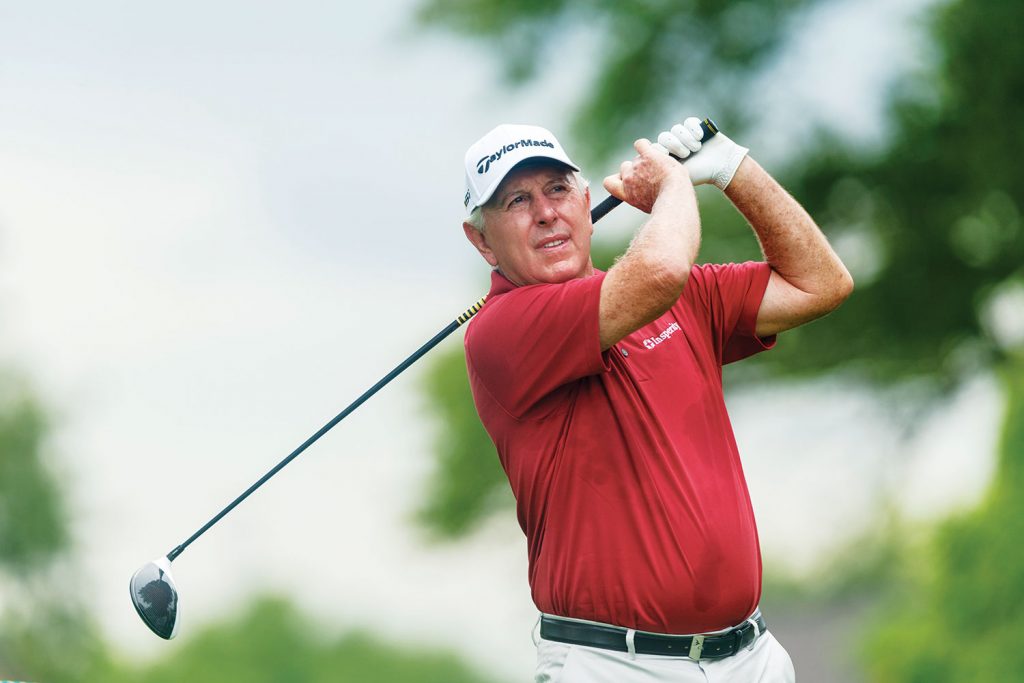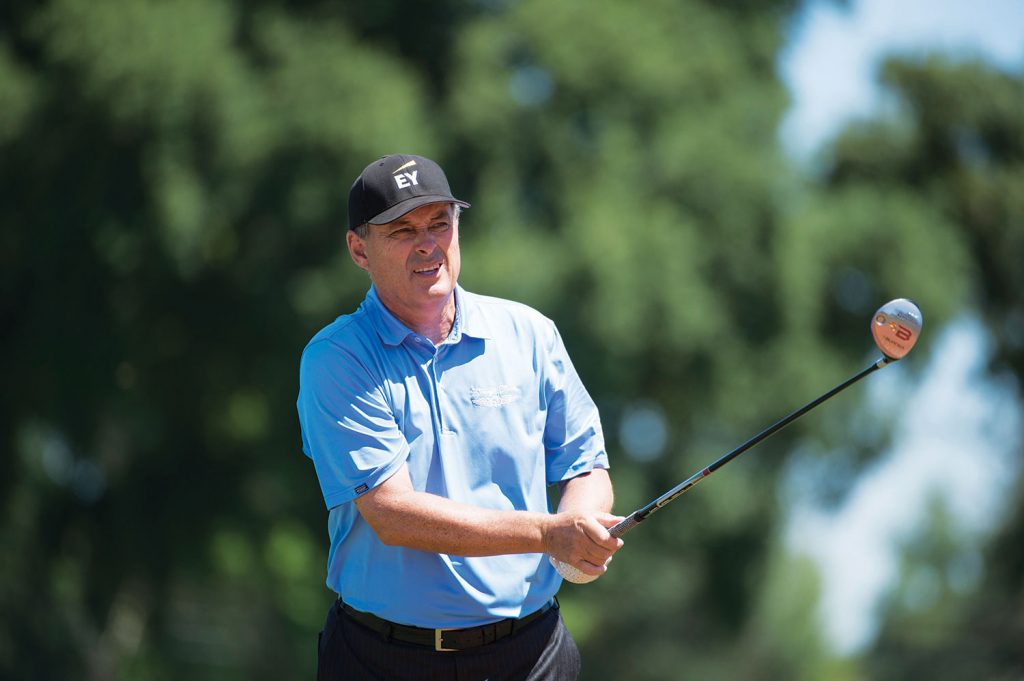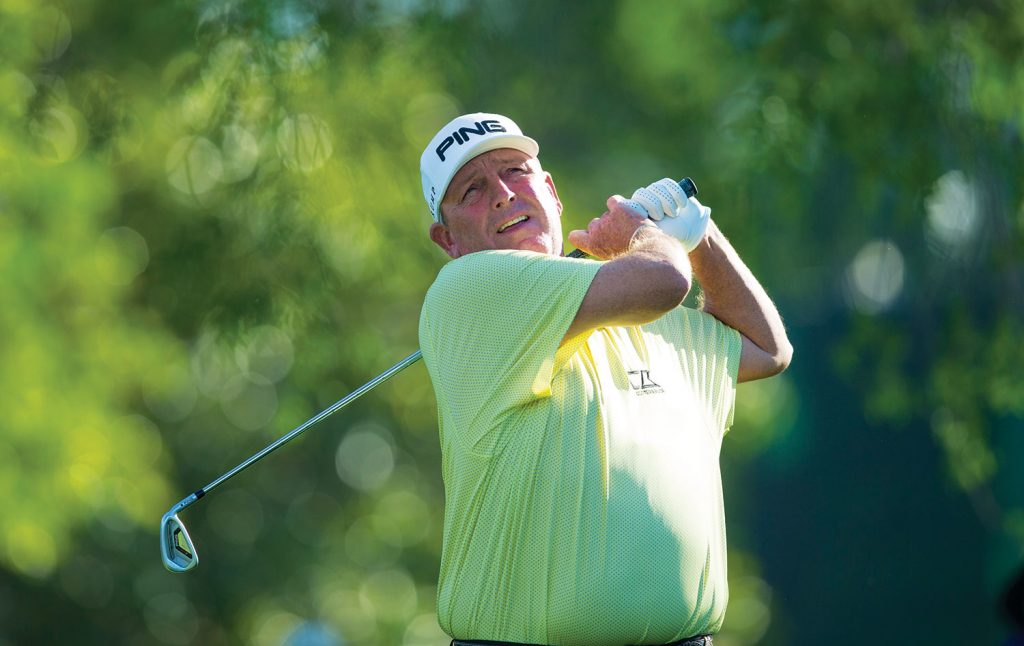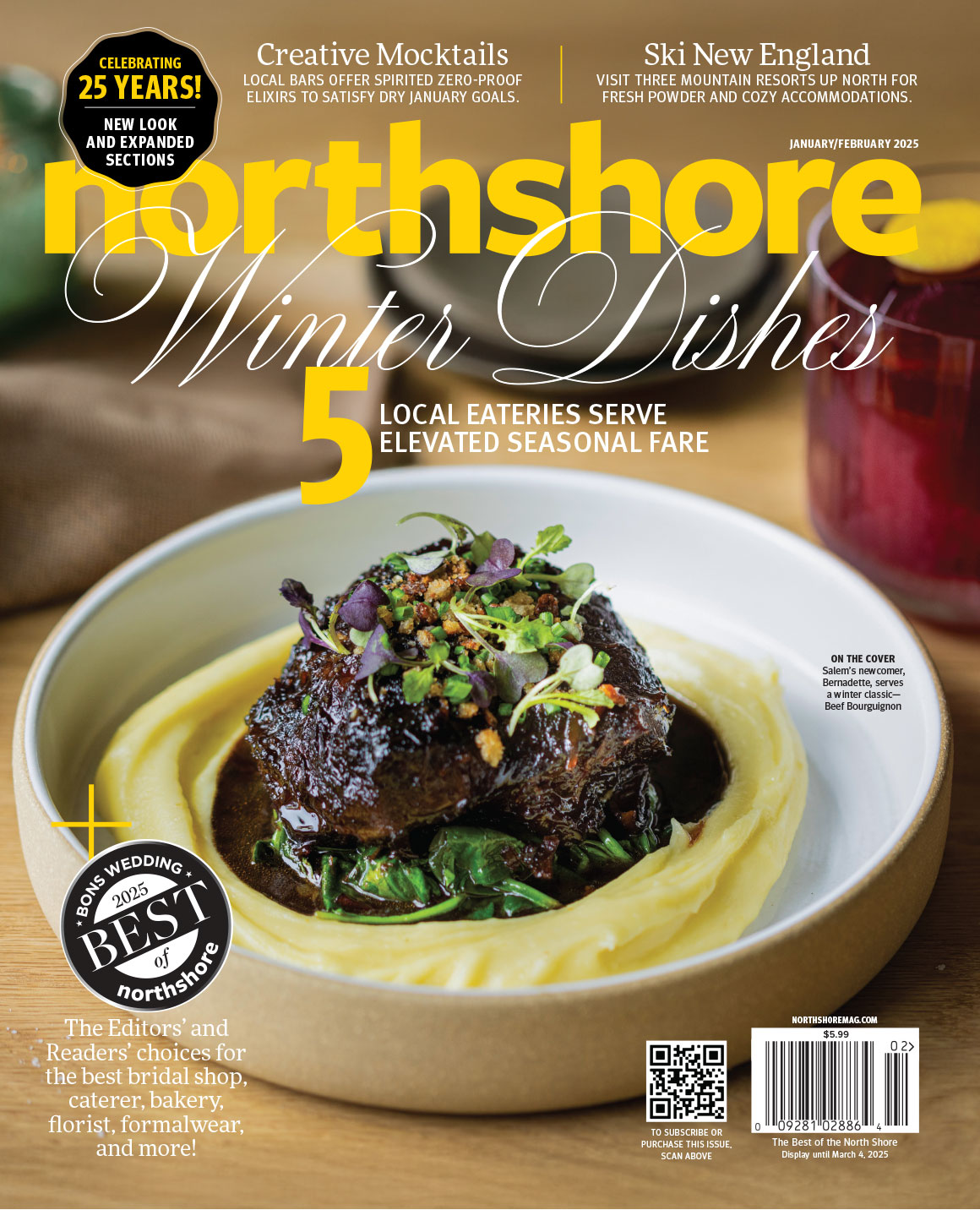Photos by USGA/Matt Sullivan
Even if you’ve never set foot on a golf course, you’ve probably heard their names: Hale Irwin, Loren Roberts, Mark Calcavecchia. These are golf’s senior statesmen, and in June, fans from across the country will line the course at the Salem Country Club to watch them battle for a spot atop the leaderboard at the 2017 U.S. Senior Open.
“This area is a hotbed of golf enthusiasts,” says Bill Sheehan, general chairman of the 2017 U.S. Senior Open and a member of the Salem Country Club since 1989 (he first caddied there when he was 12 years old). “Millions of people will be watching the tournament in over 100 countries. It’s a wonderful opportunity to showcase the club and the city.”
The Salem Country Club last hosted the U.S. Senior Open in 2001. That tournament sold out, drawing some 140,000 fans to the North Shore. Organizers say this year’s event, which runs June 26-July 2, will be no different.
Northshore spoke with Irwin, Roberts, and Calcavecchia about their illustrious careers, their personal lives, and their take on New England’s rough-and-tumble fairways. Oh, and if you’re looking for tips on improving your game, we covered that, too.

Hale Irwin
At 72, Hale Irwin is a member of the World Golf Hall of Fame and one of only a handful of players to win the U.S. Open three times. He then went on to win the U.S. Senior Open twice. And the accolades go on: 10 Majors wins, 45 PGA Champions Tour wins, five Ryder Cup appearances.
These days, Irwin stays busy on the Champions Tour and designs award-winning golf courses with his son, Steve. After our interview, he followed up to say that he misspoke—he had, in fact, played Salem Country Club back in the day. No worries, Hale. After five decades in the game and thousands of rounds of golf, we’ll give you a mulligan.
Northshore magazine: You’ve been a pro almost 50 years and been in the game almost all your life—and you’ve earned some amazing career success. But what has golf meant to you personally?
Hale Irwin: Probably the thing that helped me the most is the self-awareness that one has to have to play the game at a successful level. You have to understand your assets and liabilities and take that realistic pill every morning when you look in the mirror. Golf is not a game where a teammate can carry you. You have to do it on your own and take the glory or consequences. And that helps define one’s character.
NS: Some pros go their whole career without a U.S. Open title. You’ve won five times. What makes this tournament so special for you?
HI: When I was a young teenager out there practicing, I would pretend this was the shot that won the U.S. Open. I was an amateur and couldn’t play in the PGA. And the British Open? Gosh, I could hardly get out of Colorado, much less go to Great Britain. I did have the opportunity to qualify for a U.S. Open championship, though, so that was the nearest thing to me. You have to have some imagination. And I did qualify for it as an amateur back in 1966, when I was 21.
NS: And where did you finish in the tournament?
HI: I don’t know! (Laughs.) But I remember I was one of the few amateurs and I was in the first group out. And I remember the USGA came out to me and my playing companion and they near read us the riot act on how to play fast. Scared me to death, timing us on every hole. That might have been the fastest round I ever played.
NS: You and your son, Steve, have designed more than two dozen courses, including several on the East Coast. What makes for a well-designed course?
HI: My motto has always been that if people that play the course after 18 holes go to the 19th hole and talk about how much fun they had and go back the next day, then we’re successful. For some of the designers to go out and build these monuments unto themselves that no one can play, it’s doing a disservice to the golf community.
That doesn’t mean you have to design something easy, but you have to give them an opportunity to succeed; otherwise, they won’t come back. If they aren’t challenged but at the same time rewarded, then you haven’t done your job.
NS: As a designer and player, what’s unique about golfing here in the Northeast?
HI: It’s the terrain. Some of the best golf courses on which I’ve played are in New England. You have natural rock outcroppings and some superb topography to build courses. Some of the best architects built tremendous golf courses in that part of world.
And as a player, with hills, you’re not really sure how far that tree or green or shot you’re trying to play is without accurate yardage. It can be deceiving, and the lies bring tremendous variety to the game.
NS: Do you have any personal connections to Massachusetts?
HI: Yeah, I had a nephew who played for the New England Patriots under (Coach Bill) Parcells, Heath Irwin. He was an offensive lineman—primarily a left guard, but he also played center. So I had the opportunity to go up there and see a couple of games and sit with Mr. Kraft, and we had a good time.

Loren Roberts
Starting in 1994, Loren Roberts unleashed an impressive series of eight PGA Tour wins in nine years. But becoming Loren Roberts the champion took years of playing as Loren Roberts the struggling pro. The 62-year-old didn’t win his first PGA Tour event until he was 38. At one point, he was nearly broke and considered giving up his career altogether.
Three decades later, Roberts is one of the game’s most accomplished athletes, with more than two dozen professional wins and a short game worthy of serious envy.
NS: Your golf story is one of persistence, if nothing else. What has golf meant to you in those moments when your game and life behind the scenes have been challenging, and still you teed off?
LR: When I started out, I just remember my wife and I had just about everything we owned in the back of an old ’78 Oldsmobile driving around the country trying to play the Tour, ya know?
And I remember in 1983, I had missed the cut at the Milwaukee Open and hadn’t hardly made any money at all. Basically, I was broke. And I came back to the (hotel) room and I said, “Wait a minute here, what am I gonna do?”
But my wife was very encouraging and we were a team and she really stuck in there. I got my (PGA) card back and the next year I played decently, and from then on, I kept working at it. But it was close. There were a couple moments when I thought about giving up and being a club pro.
NS: What is it about the game that kept you going, despite the frustrations?
LR: The game of golf fits my personality type. I could stand there for an hour and try to get the right flight and make it go exactly where I’m looking. And I like the fact that golf is one of the only sports where you don’t react to the movement of the ball—the ball reacts to your movement. It just sits there until you decide to do something to it. So it tends to bring your brain into it and gives you a lot of options.
I also enjoy playing because you’re your own boss. It’s the purest form of capitalism. The more you work, the more successful you can be. If you don’t play well and you miss the cut, you don’t get a check. It sounds harsh, but I like that.
NS: You’ve come as close as one can to mastering every golfer’s Achilles heel in your putting, and it’s earned you the nickname “Boss of the Moss.” What level of practice does it take to be that consistent on the greens?
LR: I have a general rule of thumb that as many hours as I spend hitting balls on the range, I would spend (the same number of hours) doing a short game: chipping, bunker plays, and putting.
But there’s not one way to putt. You have to find the way that fits your ability and what works with the rest of your game. I’m a pure speed guy. I don’t get hung up on a lot of mechanics or hitting the ball at a specific spot. I just see the overall shot and try to create it with the right ball speed.
NS: Any plans for some North Shore excursions while you’re up here? Whale watching? Clambake?
LR: I’m having lobster when I get up there—that’s the first thing I’m having. But you can tell me where to go.
NS: If you want lobster, you can’t go wrong with Roy Moore Lobster Shack in Rockport. Just go downtown and ask anyone around there, and they’ll point you to it.
LR: Sounds good.

Mark Calcavecchia
In the golfing world, they call him “Calc.” Mark Calcavecchia, 57, grew up in Nebraska and Florida and turned pro in 1981. Since then, he has racked up dozens of wins and an unusual set of golfing records. He’s also no stranger to what he calls New England’s “old-school” brand of golf.
NS: We all know Calc the pro, but where did your love of the game begin? When did you pick up your first club, and who taught you how to play?
MC: I spent the first 13 years of my life in a small town in northeast Nebraska called Laurel. We had a nine-hole course right outside of town, and I just tagged along with my older brother and my dad and kinda figured it out on my own. I started with a putter and got my first short set of clubs when I was 5, maybe 6 years old. And I just fell in love with the game.
By the time I got down to Florida, I played on the junior high school team, and then the high school team, and then at the University of Florida for three years.
NS: This isn’t your first go-round at a U.S. Open, but if you take it, it would be your first U.S. Open win. What would that mean to you at this point in your career?
MC: It would be huge. It’s our biggest tournament in senior golf, without a doubt. The British Senior Open is probably second biggest. I had a good chance to win at Inverness (Club in 2011), but I came in third that year. Playing well at a major championship, especially a USGA event, is awesome. Winning it would be amazing.
NS: You hold a lot of cool records: lowest back nine at the Masters, 32 birdies in 72 holes at the Phoenix Open. You also broke a PGA Tour record by birdying nine straight holes at the RBC Canadian Open. Your son, Eric, was caddying for you that day. What was it like to share that experience with him?
MC: I remember how excited he was when I made the fourth birdie in a row. He was like, “Dad, that’s four,” giving me a high five. And the next hole’s a par five, and I made five in a row. He was just in a state of shock when I got passed the sixth birdie, and I ended up making nine in a row. We still talk about that.
NS: You grew up in Florida and have played all over the world. How does golfing in New England compare?
MC: I spent a lot of time in the ’80s in Connecticut in the Danbury area. I played Salem Country Club back in the ’80s, and I remember loving it. It’s old-school, good old fashioned golf where you gotta drive it well.
NS: What’s your impression of the golfing community up here in New England?
MC: The crowds are fantastic. [This year’s tournament] is gonna be a sellout, and the crowds are going to really enjoy having the senior tour up there.
The U.S. Senior Open is a different atmosphere than a PGA Tour event. It’s more laid back, even though it is the U.S. Open. So the fans will really enjoy being able to interact with the players.
Salem Country Club
133 Forest St., Peabody
978-538-5400
2017 U.S. Senior Open
